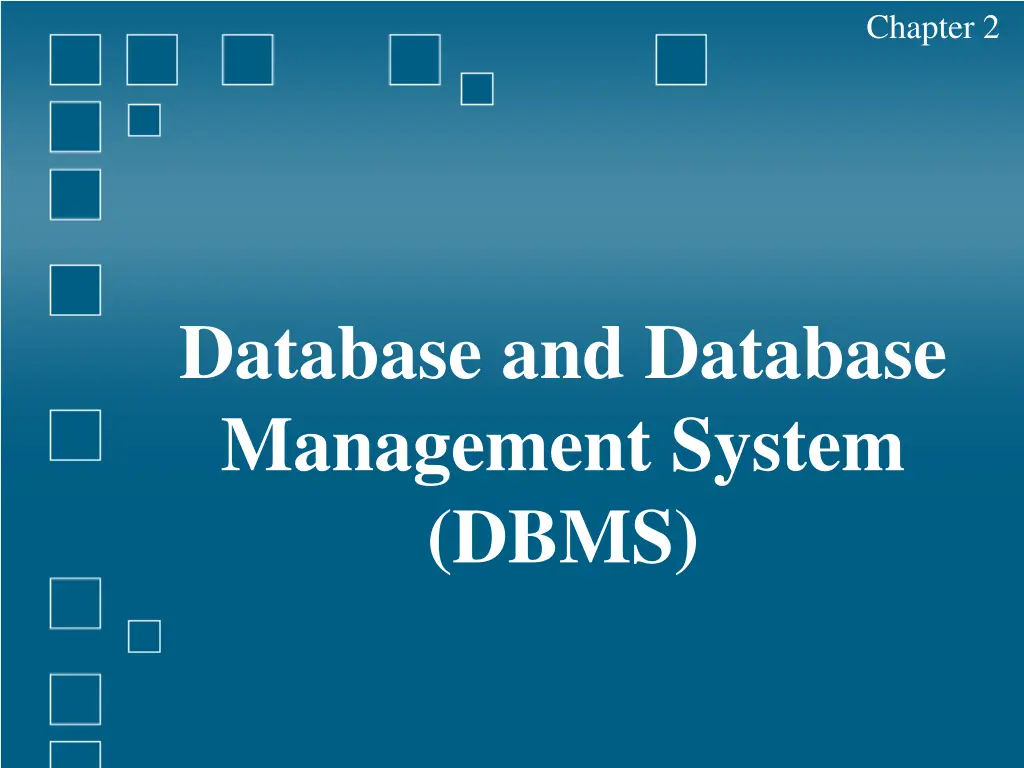
Database Management Systems: Overview and Applications
Explore the fundamentals of database management systems (DBMS), including their architecture, advantages, components, and importance. Learn about different types of databases and their applications in various industries such as banking, airlines, universities, and telecommunication. Discover the role of SQL in querying and updating databases.
Download Presentation

Please find below an Image/Link to download the presentation.
The content on the website is provided AS IS for your information and personal use only. It may not be sold, licensed, or shared on other websites without obtaining consent from the author. If you encounter any issues during the download, it is possible that the publisher has removed the file from their server.
You are allowed to download the files provided on this website for personal or commercial use, subject to the condition that they are used lawfully. All files are the property of their respective owners.
The content on the website is provided AS IS for your information and personal use only. It may not be sold, licensed, or shared on other websites without obtaining consent from the author.
E N D
Presentation Transcript
Chapter 2 Database and Database Management System (DBMS)
Chapter 2 Introduction Database management system (DBMS) Advantages of DBMS Architecture of DBMS Importance of DBMS Components of DBS environment Data independence Instance , schema and mapping ACID test
Chapter 2 1. Introduction A databaseis a collection of information that is organized so that it can easily be accessed, managed, databases can be classified according to types of content: bibliographic, full-text, numeric, and images. and updated.
In computing, databases are classified according to their organizational approach: relational database a tabular database A distributed database: is one that can be dispersed or replicated among different points in a network. An object-oriented programming database is one that is congruent with the data defined in object classes and subclasses.
Chapter 2 Computer databases typically contain aggregations of data records or files, such as sales transactions, product catalogs and inventories, and customer profiles. a database manager provides users the capabilities of controlling read/write access, specifying report generation, and analyzing usage. Databases and database managers are prevalent in large mainframe systems, but are also present in smaller distributed workstation and mid-range systems such as the AS/400 and on personal computers.
Chapter 2 SQL(Structured Query Language) is a standard language for making interactive queries from and updating a database such as IBM's Microsoft's SQL Server, and database products from Oracle, Sybase, and Computer Associates. DB2,
Chapter 2 1.1 Database System Applications Databases are widely used. Here are some representative applications: Banking: For customer information, accounts, and loans, and banking transactions. Airlines: For reservations and schedule information. Airlines were among the first to use databases in a geographically distributed manner terminals situated around the world accessed the central database system through phone lines and other data networks. Universities: For student information, course registrations, and grades. Credit card transactions: For purchases on credit cards and generation of monthly statements.
Chapter 2 Telecommunication: For keeping records of calls made, generating monthly bills, maintaining balances on prepaid calling cards, and storing information about the communication networks. Finance: For storing information about holdings, sales, and purchases of financial instruments such as stocks and bonds. Sales: For customer, product, and purchase information. Manufacturing: For management of supply chain and for tracking production of items in factories, inventories of items in warehouses/stores, and orders for items. Human resources: For information about employees, salaries, payroll taxes and benefits, and for generation of paychecks.
Chapter 2 2.1.2 Database Administrator One of the main reasons for using DBMSs is to have central control of both the data and the programs that access those data. DataBase Administrator (DBA): A person who has such central control over the system.
Chapter 2 The functions of a DBA include: 1. Schema definition. The DBA creates the original database schema by executing a set of data definition statements in the DDL. 2. Storage structure and access-method definition. 3. Schema and modification. The DBA carries out changes to the schema and physical organization to reflect the changing needs of the organization, or to alter the physical organization to improve performance. physical-organization
Chapter 2 4. Granting of authorization for data access. By granting different types of authorization, the database administrator can regulate which parts of the database various users can access. The authorization information is kept in a special system structure that the database system consults whenever someone attempts to access the data in the system.
Chapter 2 5. Routine maintenance. Examples of the database administrator s routine maintenance activities are: Periodically backing up the database, either onto tapes or onto remote servers, to prevent loss of data in case of disasters such as flooding. Ensuring that enough free disk space is available for normal operations, and upgrading disk space as required. Monitoring jobs running on the database and ensuring that performance is not degraded by very expensive tasks submitted by some users.
Chapter 2 2 . Database management system (DBMS) is a collection of interrelated data and a set of programs to access those data. The collection of data, usually referred to as the database, contains information relevant to an enterprise. The primary goal of a DBMS is to provide a way to store and retrieve database information that is both convenient and efficient.
Chapter 2 Database systems are designed to manage large bodies of information. Management of data involves both defining structures for storage of information and providing mechanisms manipulation of information. In addition, the database system must ensure the safety of the information stored, despite system crashes or attempts at unauthorized access. If data are to be shared among several users, the system must avoid possible anomalous results. for the
Chapter 2 2.2.1 Advantages of DBMS 1. Database organizations to place control of database development in the hands of database administrators (DBAs) and other specialists. 2. Data independence: Application programs should be as independent as possible from details of data representation and storage. The DBMS can provide an abstract view of the data to insulate application code from such details. Development: It allows
Chapter 2 3. Efficient data access: A DBMS utilizes a variety of sophisticated techniques to store and retrieve data efficiently. It allows different user application programs to easily access the same database. Instead of having to write computer programs to extract information, user can ask simple questions in a query language
Chapter 2 4. Data integrity and security: If data is always accessed through the DBMS, the DBMS can enforce : Integrity constraints on the data. For example, before inserting salary information for an employee, the DBMS can check that the department budget is not exceeded. Also, the DBMS can enforce access controls that govern what data is visible to different classes of users.
Chapter 2 4. Crash recovery: the DBMS protects users from the effects of system failures. 5. Data administration and Concurrent access: When several users share the data( more than one user access the database at the same time), DBMS schedules concurrent accesses to the data in such a manner that users can think of the data as being accessed by only one user at a time.
Chapter 2 2.2.2 The Three-Schema Architecture The goal of the three-schema architecture, is to separate the user applications from the physical database. In this architecture, schemas can be defined at the following three levels: 1. The internal level has an internal schema, which describes the physical storage structure of the database. The internal schema uses a physical data model and describes the complete details of data storage and access paths for the database.
Chapter 2 2. The conceptual level has a conceptual schema, which describes the structure of the whole database for a community of users. The conceptual schema hides the details of physical storage structures and describing entities, data types, relationships, user operations, and constraints. Usually, a representational data model is used to describe the conceptual schema when a database system is implemented. This implementation conceptual schema is often based on a conceptual schema design in a high-level data model. concentrates on
Chapter 2 3.The external or view level includes a number of external schemas or user views. Each external schema describes the part of the database that a particular user group is interested in and hides the rest of the database from that user group. The processes of transforming requests and results between levels are called mappings.
Chapter 2 Figure 2.1 The three level of architecture
Chapter 2 3 Data Independence The three-schema architecture can be used to explain the concept of data independence, which can be defined as the capacity to change the schema at one level of a database system without having to change the schema at the next higher level. We can define two types of data independence:
Chapter 2 1.Logical data independence 2.Physical data independence
Chapter 2 1. Logical data independenceis the capacity to change the conceptual schema without having to change external schemas or application programs. We may change the conceptual schema to expand the database (by adding a record type or data item), or to reduce the database (by removing a record type or data item).
Chapter 2 external schemas that refer only to the remaining data should not be affected. Only the view definition and the mappings need be changed in a DBMS that supports logical data independence. Application programs that reference the external schema constructs must work as before, after the conceptual schema undergoes reorganization. Changes to constraints can be applied also to the conceptual schema without affecting the external schemas or application programs. a logical
Chapter 2 2. Physical data independenceis the capacity to change the internal schema without having to change the conceptual (or external) schemas. Changes to the internal schema may be needed because some physical files had to be reorganized for example, by creating additional access structures to improve the performance of retrieval or update. If the same data as before remains in the database, we should not have to change the conceptual schema.
Chapter 2 .4 Components of Database System Environment The term database system refers to an organization of components that define and regulate the collection, storage, management, and use of data within a database environment. From a general management point of view, the database system is composed of the five major parts shown in the following Figure 2.2: hardware, software, people, procedures, and data.
Chapter 2 Figure 2.2 Components of database system environment
Chapter 2 1. Hardware. Hardware refers to all of the system s physical devices; for example, workstations, servers, and supercomputers), storage devices, printers, network devices (hubs, switches, routers, fiber optics),and other devices (automated teller machines, ID readers, and so on). computers (PCs,
Chapter 2 2. Software. Although the most readily identified software is the DBMS itself, to make the database system function fully, three types of software are needed: operating system software, DBMS software, and application programs and utilities.
Chapter 2 a. Operating System software: manages all hardware components and makes it possible for all other software to run on the computers. Examples of operating system software include Microsoft Windows, Linux, MacOS, UNIX, and MVS. b. DBMS software: manages the database within the database system. Some examples of DBMS software include Microsoft s SQL Server, Oracle Corporation s Oracle, Sun s MySQL, and IBM s DB2.
Chapter 2 c. Application programs and utility software: Are used to access and manipulate data in the DBMS and to manage the computer environment in which data access and manipulation take place. Application programs are most commonly used to access data found within the database to generate reports, tabulations, and other information to facilitate decision making. Utilities are the software tools used to help manage the database system s computer components. For example, all of the major DBMS vendors now provide graphical user interfaces (GUIs) to help create database structures, control database access, and monitor database operations.
Chapter 2 3. People: This component includes all users of the database system. On the basis of primary job functions, five types of users can be identified in a database system: 1.system administrators 2.database administrators 3.database designers 4.system analysts and programmers 5.end users Each user type performs both unique and complementary functions.
Chapter 2 1. System administrators oversee the database system s general operations. 2. Database administrators, also known as DBAs, manage the DBMS and ensure that the database is functioning properly.
Chapter 2 3. Database designers design the database structure. They are, in effect, the database architects. If the database design is poor, even the best application programmers and the most dedicated DBAs cannot produce a useful database environment. Because organizations strive to optimize their data resources, the database designer s job description has expanded to cover new dimensions responsibilities. and growing
Chapter 2 4. System analysts and programmersdesign and implement the application programs. They design and create the data entry screens, reports, and procedures through which end users access and manipulate the database s data. 5. End usersare the people who use the application programs to run the organization s daily operations. For example, salesclerks, supervisors, managers, and directors are all classified as end users. High-level end users employ the information obtained from the database to make tactical and strategic business decisions.
Chapter 2 4. Procedures. Procedures are the instructions and rules that govern the design and use of the database system. Procedures are a critical, although occasionally forgotten, component of the system. Procedures play an important role in a company because they enforce the standards by which business is conducted within the organization and with customers. Procedures are also used to ensure that there is an organized way to monitor and audit both the data that enter the database and the information that is generated through the use of those data.
Chapter 2 5. Data. The word data covers the collection of facts stored in the database. Because data are the raw material from which information is generated, the determination of what data are to be entered into the database and how those data are to be organized is a vital part of the database designer s job.
Chapter 2 Figure 2.3 Database system (Database (DB) + DBMS Database System (DBS))
Chapter 2 2.5 Instance , schema and mapping Databases change over time as information is inserted and deleted. information stored in the database at a particular moment is called an instance of the database. The overall design of the database is called the database schema. Schemas are changed infrequently. The collection of
Chapter 2 The concept of database schemas and instances can be understood by analogy to a program written in a programming language. A database schema corresponds to the variable declarations (along with associated type definitions) in a program. Each variable has a particular value at a given instant. The values of the variables in a program at a point in time correspond to an instance of a database schema.
Chapter 2 Database partitioned according to the levels of abstraction: systems have several schemas, Physical schema describes the database design at the physical level. Logical schema describes the database design at the logical level. Subschemas describes different views of the database at the view level
Chapter 2 Employee-schema=(emp-id, emp-name, salary,sex,department). Employee emp-id emp-name salary sex department the logical schema is by far the most important since programmers construct applications by using the logical schema. The physical schema is hidden beneath the logical schema, and can usually be changed easily without affecting application programs. Application programs are said to exhibit physical data independence if they do not depend on the physical schema, and thus need not be rewritten if the physical schema changes.
Chapter 2 6 ACID Model ACID (Atomicity, Consistency, Isolation, Durability) is a set of properties that guarantee database transactions are processed reliably. A transaction a single logical operation on the data is called a transaction. For example, a transfer of funds from one bank account to another, even though that might involve multiple changes (such as debiting one account and crediting another), is a single transaction.
Chapter 2 The ACID model is one of the oldest and most important concepts of database theory. There are four goals that every database management system should be consistency, isolation and durability. No database can be considered reliable if the database fails to meet any of these four goals. Jim Gray defined these properties of a reliable transaction system in the late 1970s and developed technologies to automatically achieve them. achieved: atomicity,
Chapter 2 6.1 Characteristics of ACID Test 1. Atomicity Atomicity requires that database modifications must follow an "all or nothing" rule. Each transaction is said to be atomic. If one part of the transaction fails, the entire transaction fails and the database state is unchanged. It is important that the database management system maintain the atomic nature of transactions in spite of any DBMS, operating system or hardware failure.
Chapter 2 6.1 Characteristics of ACID Test 1. Atomicity Atomicity requires that database modifications must follow an "all or nothing" rule. . . .
Chapter 2 Each transaction is said to be atomic. If one part of the transaction fails, the entire transaction fails and the database state is unchanged. It is important that the database management system maintain the atomic nature of transactions in spite of any DBMS, operating system or hardware failure.
Chapter 2 2. Consistency Consistency states that only valid data will be written to the database. If a transaction is executed that violates the database s consistency rules, the entire transaction will be rolled back and the database will be restored to the state consistent with those rules. if a transaction successfully executes, it will take the database from one state that is consistent with the rules to another state that is also consistent with the rules.






















